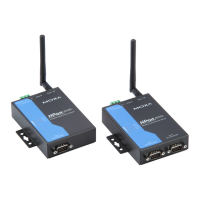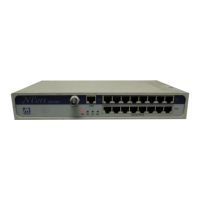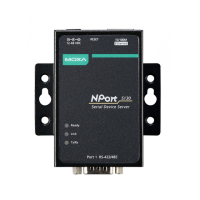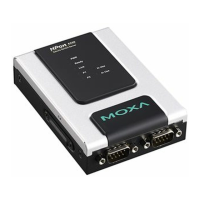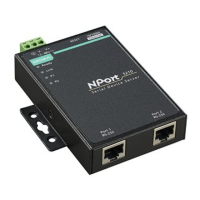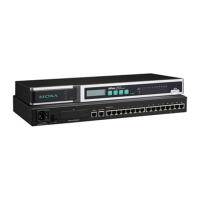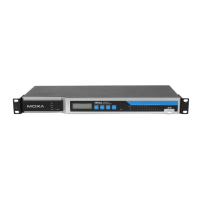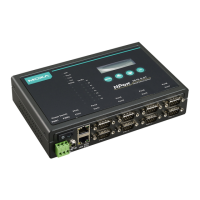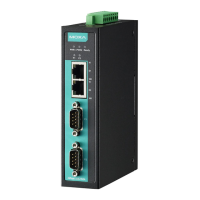Do you have a question about the Moxa Technologies NPort W2150A and is the answer not in the manual?
| Brand | Moxa Technologies |
|---|---|
| Model | NPort W2150A |
| Category | Server |
| Language | English |
Introduction to the basic features and specifications of the NPort W2150A/W2250A Series.
Lists standard and optional accessories included with the NPort device.
Highlights key functionalities and capabilities of the NPort W2150A/W2250A Series.
Details the technical specifications of the Ethernet, WLAN, and Serial interfaces.
Diagram and table showing pin configurations for RS-232, RS-422, and RS-485 interfaces.
Explains the hardware features and how to connect the NPort device server.
Identifies the physical ports and indicators on the NPort W2150A/W2250A units.
Describes the function of each LED on the NPort's top and end panels.
Instructions for setting termination resistors for RS-422/485 environments.
Discusses various methods for physically installing the NPort device.
Provides safety precautions and guidelines for connecting the NPort hardware.
Introduces methods for assigning the NPort's IP address for the first time.
Specifies the default IP addresses for LAN and WLAN interfaces.
Details how to assign an IP address using the ARP command.
Step-by-step guide to configuring IP via Telnet console interface.
Instructions for configuring IP via the serial console interface.
Explains the different serial port operation modes available on the NPort.
Describes how RealCOM mode maps NPort serial ports to host COM ports.
Explains RFC2217 mode for virtual COM port mapping via Telnet.
Details how the NPort acts as a TCP server for serial port connections.
Explains how the NPort acts as a TCP client to connect to a network host.
Describes the UDP mode for faster, more efficient data transmission.
Explains modes for serial-to-serial communication over Ethernet.
Details how the NPort functions as an Ethernet modem.
Introduces the NPort web console and basic configuration options.
Instructions for enabling cookies in web browsers for console access.
Guide to accessing and logging into the NPort web console.
Configuration for server name, location, time zone, local time, and time server.
Explains how to configure settings within the Network Settings folder.
Configuration of DNS server addresses for network name resolution.
Configuration of IP address, netmask, and gateway for the Ethernet interface.
Configuration of IP settings for the wireless LAN interface.
Settings for configuring Ad-hoc or Infrastructure WLAN modes.
Configuration of authentication and encryption for WLAN security.
Configuration options like Gratuitous ARP for network behavior.
Explains how to configure settings within the Serial Port Settings folder.
Selection and configuration of serial port modes (RealCOM, TCP, UDP, etc.).
Specific settings for the RealCOM operation mode.
Specific settings for the RFC2217 operation mode.
Specific settings for the TCP Server operation mode.
Specific settings for the TCP Client operation mode.
Specific settings for the UDP operation mode.
Configuration for serial-to-serial communication modes.
Specific settings for the Ethernet Modem operation mode.
Configuration of serial communication settings like Baud rate, Parity, Data bits.
Settings for enabling port buffering and serial data logging.
Explains how to configure settings within the System Management folder.
Settings for accessible IP lists and SNMP agent configuration.
Configuration for event notifications via email or SNMP traps.
Options for console access, ping tests, firmware upgrades, and config management.
Procedures for importing SSL certificates for secure communication.
Explains how to use system monitoring functions on the web console.
Monitoring of serial port connections and error counts.
Monitoring of network connections, system logs, and WLAN status.
Tool for viewing wireless signal strength and characteristics without extra software.
How to save configuration changes and restart the NPort.
Procedure to restart the entire NPort device.
Procedure to restart individual serial ports on the NPort.
Guide to installing NPort Windows Driver Manager, Search Utility, and Linux/UNIX drivers.
Utility for installing and managing NPort COM drivers for COM mapping.
Utility for finding, modifying IP, and upgrading firmware of NPort device servers.
Instructions for mapping Linux host TTY ports to NPort serial ports.
Information on mapping UNIX host TTY ports to NPort serial ports.
Lists standard MIB-II groups and their variable implementation for NPort.
SNMP variables organized into System, Interfaces, IP, ICMP, UDP, TCP, and SNMP categories.
MIB objects specific to RS-232 interfaces, including general and async port tables.
Lists common TCP/UDP port numbers that may cause conflicts.
How the NPort handles incoming TCP/IP connection requests in modem mode.
How the NPort uses ATD commands to initiate TCP connections.
Common AT commands supported by the NPort in Ethernet Modem mode.
Explains the function of various S registers used for modem control.
Statement on compliance with FCC RF radiation exposure limits.
Information on device labeling compliance with FCC rules.
Warning regarding antenna installation and RF exposure compliance.
Requirements for labeling the final end product containing the transmitter module.
Warning that unauthorized modifications can void user authority to operate equipment.
Guidance on maintaining FCC RF exposure compliance and using supplied antenna.
